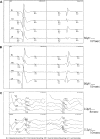Use of α(2)-Agonists in Neuroanesthesia: An Overview
- PMID: 21603337
- PMCID: PMC3096156
Use of α(2)-Agonists in Neuroanesthesia: An Overview
Abstract
α(2)-Agonists are a novel class of drugs with mechanisms of action that differ from other commonly used anesthetic drugs. They have neuroprotective, cardioprotective, and sedative effects. These unique characteristics make them potentially useful during neuroanesthesia and intensive care. We review the effects of dexmedetomidine on cerebral blood flow and cerebral metabolism, along with recent advances in using α(2)-agonists in neuroanesthesia and neurointensive care.
Keywords: Alpha-2 agonist; anesthesia; dexmedetomidine; neuroanesthesia; neuroprotection.
Figures



Similar articles
-
The use of dexmedetomidine in anesthesia and intensive care: a review.Curr Pharm Des. 2012;18(38):6257-65. doi: 10.2174/138161212803832272. Curr Pharm Des. 2012. PMID: 22762468 Review.
-
Dexmedetomidine in the neurointensive care unit.Discov Med. 2010 Jan;9(44):42-5. Discov Med. 2010. PMID: 20102684 Review.
-
Perspectives on Dexmedetomidine Use for Neurosurgical Patients.J Neurosurg Anesthesiol. 2019 Oct;31(4):366-377. doi: 10.1097/ANA.0000000000000554. J Neurosurg Anesthesiol. 2019. PMID: 30363004 Review.
-
[Neuroprotection in neuroanesthesia: current practices in Germany].Anaesthesist. 2000 May;49(5):412-9. doi: 10.1007/s001010070109. Anaesthesist. 2000. PMID: 10883355 German.
-
Dexmedetomidine: current role in anesthesia and intensive care.Rev Bras Anestesiol. 2012 Jan-Feb;62(1):118-33. doi: 10.1016/S0034-7094(12)70110-1. Rev Bras Anestesiol. 2012. PMID: 22248773 Review.
Cited by
-
Dexmedetomidine: New avenues.J Anaesthesiol Clin Pharmacol. 2011 Jul;27(3):297-302. doi: 10.4103/0970-9185.83670. J Anaesthesiol Clin Pharmacol. 2011. PMID: 21897496 Free PMC article. No abstract available.
-
The effect of dexmedetomidine on cerebral perfusion and oxygenation in healthy piglets with normal and lowered blood pressure anaesthetized with propofol-remifentanil total intravenous anaesthesia.Acta Vet Scand. 2017 May 3;59(1):27. doi: 10.1186/s13028-017-0293-0. Acta Vet Scand. 2017. PMID: 28468670 Free PMC article. Clinical Trial.
-
Multiple uses of dexmedetomidine in small animals: a mini review.Front Vet Sci. 2023 Jun 5;10:1135124. doi: 10.3389/fvets.2023.1135124. eCollection 2023. Front Vet Sci. 2023. PMID: 37342619 Free PMC article. Review.
-
Cerebrospinal fluid metabolic profiling reveals divergent modulation of pentose phosphate pathway by midazolam, propofol and dexmedetomidine in patients with subarachnoid hemorrhage: a cohort study.BMC Anesthesiol. 2022 Jan 27;22(1):34. doi: 10.1186/s12871-022-01574-z. BMC Anesthesiol. 2022. PMID: 35086470 Free PMC article.
-
Effect of Low-Dose Dexmedetomidine on the Anesthetic and Recovery Profile of Sevoflurane-Based Anesthesia in Patients Presenting for Supratentorial Neurosurgeries: A Randomized Double-Blind Placebo-Controlled Trial.J Neurosci Rural Pract. 2020 Apr;11(2):267-273. doi: 10.1055/s-0040-1703968. Epub 2020 Mar 17. J Neurosci Rural Pract. 2020. PMID: 32367982 Free PMC article.
References
-
- Maze M., Tranquilli W. Alpha-2 adrenoceptor agonists: defining the role in clinical anesthesia. Anesthesiology. 1991;74((3)):581–605. - PubMed
-
- Maze M., Scarfini C., Cavaliere F. New agents for sedation in the intensive care unit. Crit Care Clin. 2001;17((4)):881–897. - PubMed
-
- Kamibayashi T., Maze M. Clinical uses of alpha2-adrenergic agonists. Anesthesiology. 2000;93((5)):1345–1349. - PubMed
-
- Khan Z. P., Ferguson C. N., Jones R. M. Alpha-2 and imidazoline receptor agonists: their pharmacology and therapeutic role. Anaesthesia. 1999;54((2)):146–165. - PubMed
-
- Wheeler L. A., Gil D. W., WoldeMussie E. Role of alpha-2 adrenergic receptors in neuroprotection and glaucoma. Surv Ophthalmol. 2001;45((suppl 3)):S291–S294. - PubMed
LinkOut - more resources
Full Text Sources
